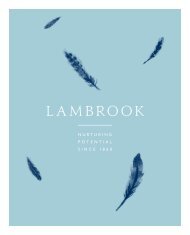Lambrook Alumni Magazine - Autumn 2019
Create successful ePaper yourself
Turn your PDF publications into a flip-book with our unique Google optimized e-Paper software.
The <strong>Lambrook</strong>ian - Issue 2<br />
75<br />
D-Day and the <strong>Lambrook</strong> Ship Remembered – John Kimbell, School Archivist<br />
YEARS ON<br />
As international events took place this year to mark the 75th anniversary<br />
of D-Day, Operation Overlord and the start of the Battle of Normandy,<br />
<strong>Lambrook</strong> joined the commemorations by recalling its eponymous ship,<br />
which carried supplies across the Channel for the troops who landed in<br />
France as part of the allied invasion on 6th June 1944.<br />
The M.V. <strong>Lambrook</strong>, a steel Motor Vessel<br />
of 10,200 tons, was built in 1942 by the<br />
Burntisland Shipbuilding Company on the<br />
Firth of Forth, Scotland, and named by Mr<br />
J. Gibson Graham, a Director, whose son<br />
Johnny Graham attended <strong>Lambrook</strong> at<br />
the time.<br />
Registered in London and first owned<br />
by the Austin Friars Steamship Co. /<br />
Galbraith, Pembroke & Co., the ship was<br />
fully ready by the early autumn of 1942 to<br />
carry cargo across the high seas, and was<br />
immediately earmarked for Government<br />
Service. She was deployed for the<br />
offensive into North Africa,<br />
and went out with one of the<br />
first convoys carrying tanks and<br />
ammunition in support of the<br />
landing troops. For the greater<br />
part of the first half of 1943, the<br />
vessel continually plied between<br />
the United Kingdom and North<br />
Africa with these supplies.<br />
When the invasion of Sicily<br />
took place later that year, the<br />
M.V. <strong>Lambrook</strong> was scheduled<br />
to take part in that operation<br />
and was again in the vanguard,<br />
not only with supplies but with<br />
considerable numbers of troops.<br />
Despite many near misses from<br />
aerial torpedoes and other<br />
hostile action, she remained<br />
unscathed and continued the good work,<br />
being one of the first vessels to arrive<br />
off the Salerno Beachhead in September<br />
1943. On this occasion, a landing craft<br />
alongside her was blown up and, as a<br />
result of Captain McInnes’ bravery, he<br />
was awarded the O.B.E. The citation read:<br />
‘Captain H. F. McInnes. For good services<br />
in M.V. <strong>Lambrook</strong>, when the ship was<br />
attacked by the enemy on a number of<br />
occasions.’<br />
The vessel was subsequently detailed to<br />
carry cargo for General Montgomery’s<br />
forces, which were at that time advancing<br />
along the east coast of Italy, but was<br />
unfortunate enough to run into an<br />
enemy mine which did considerable<br />
damage. Nevertheless, she was quickly<br />
repaired and returned to Britain for a<br />
complete overhaul in time to head for<br />
the Normandy beaches on D-Day as part<br />
of Operation Overlord, continuing to<br />
transport supplies to northern France for<br />
a further six months during the ensuing<br />
Battle of Normandy.<br />
Several Old <strong>Lambrook</strong>ians, including<br />
Vice-Admiral P. W. B. Brooking, C.B.,<br />
D.S.O., came into contact with the M.V.<br />
<strong>Lambrook</strong> during the war and Lieutenant-<br />
Commander D. R. G. Goldsmith’s<br />
destroyer escorted her in convoy on a<br />
number of occasions.<br />
From the day of the M.V. <strong>Lambrook</strong>‘s<br />
launch, the school was proud to share its<br />
name with its adopted ship. Gifts were<br />
despatched to the Captain, officers and<br />
crew, including knitted garments kindly<br />
made up by the Winkfield Section of the<br />
Women’s British Legion, and supplies of<br />
literature such as books or newspapers<br />
were forwarded from Old <strong>Lambrook</strong>ians<br />
and other friends of the School.<br />
Interesting letters, as well as souvenirs,<br />
passed regularly to and fro between the<br />
crew and the school.<br />
Having survived the hostilities, and in<br />
as good a condition as ever, the vessel<br />
carried out more peaceful duties in the<br />
service of commercial trade, but this in no<br />
way lessened the school’s interest in her<br />
activities.<br />
In 1951, when Galbraith,<br />
Pembroke & Company<br />
withdrew from ship owning to<br />
become ship brokers instead,<br />
the M.V. <strong>Lambrook</strong> was sold<br />
to the South American Saint<br />
Line, re-registered in Newport,<br />
and re-named the St Merriel. In<br />
1963 the vessel was bought by<br />
the Agelef Companía Naviera<br />
in Panama, where she was<br />
re-registered as the Proodos,<br />
only to be sold on in 1965 to<br />
a different Panamanian firm,<br />
and to acquire yet another new<br />
name - this time, the Elpis.<br />
Tragedy finally struck the<br />
following year on 26th June<br />
1966 when she was abandoned ablaze at<br />
sea following a diesel engine room fire.<br />
The ship had been en route from India<br />
(Mormugao) to Japan, carrying a cargo<br />
of iron ore, and was eventually towed to<br />
Sveti Kajo (Split, Croatia) on 10th January<br />
1968 for breaking up by Brodospas.<br />
Her framed portrait can now be found in<br />
the <strong>Lambrook</strong> School Office.<br />
20








